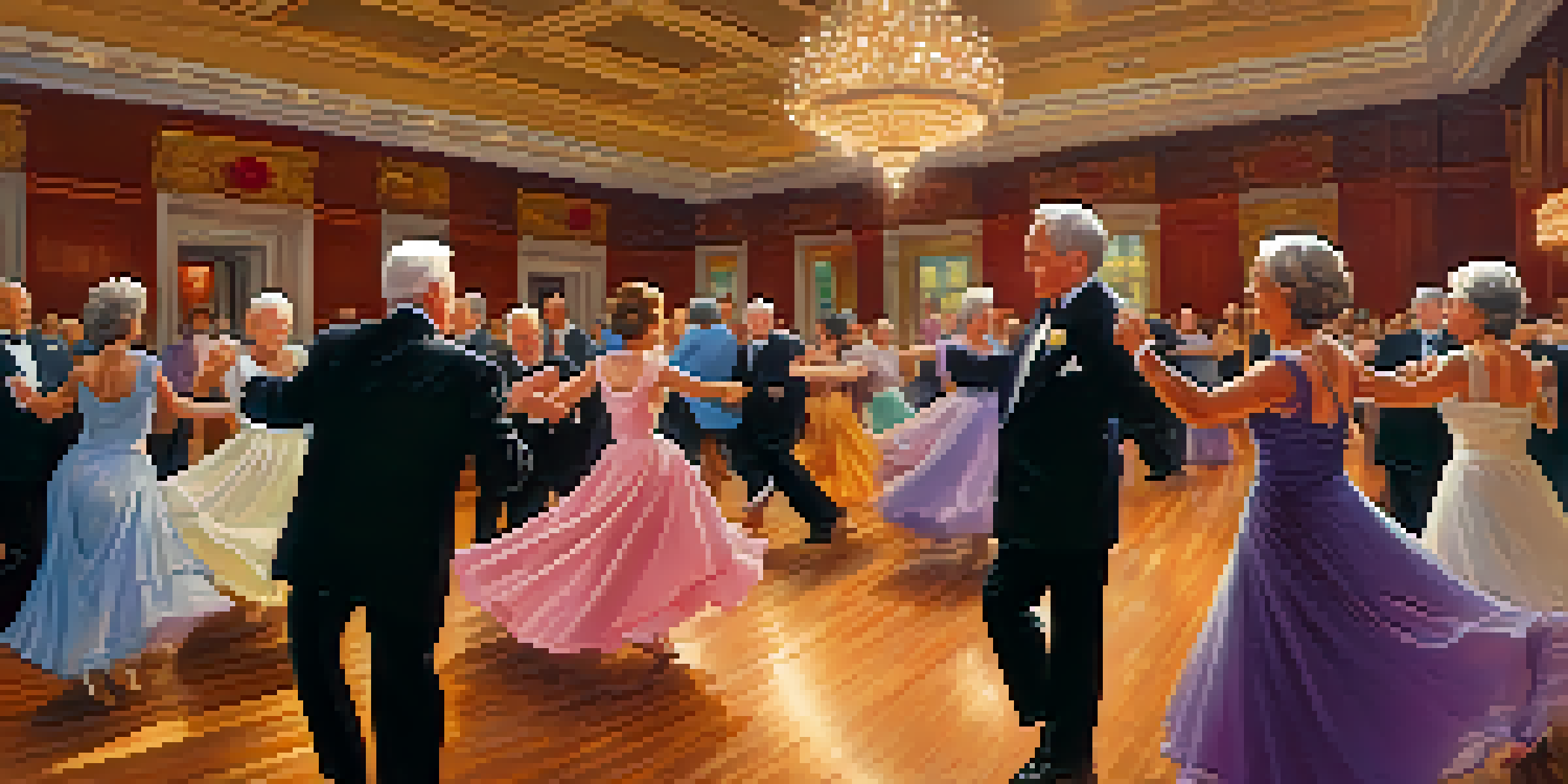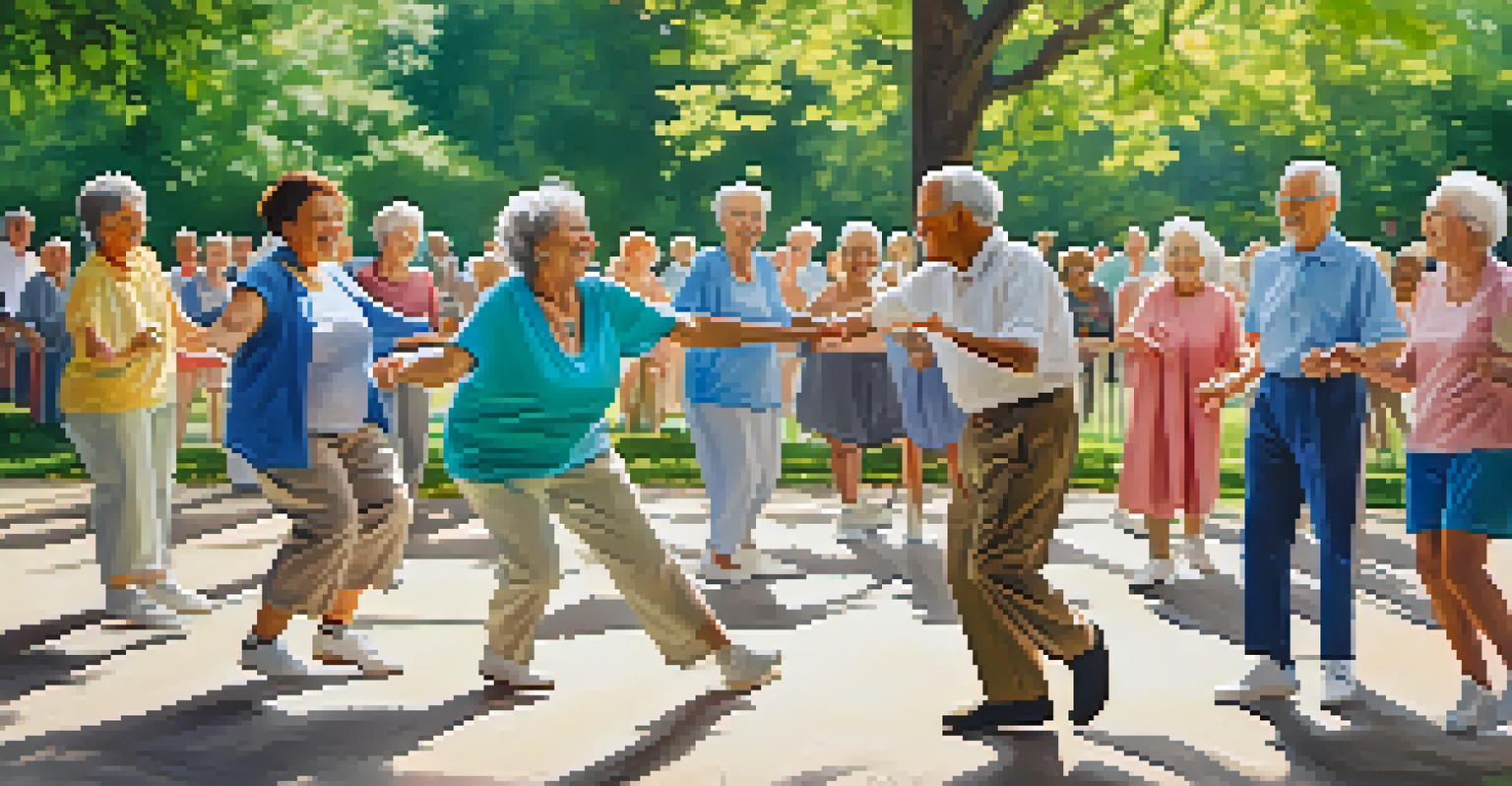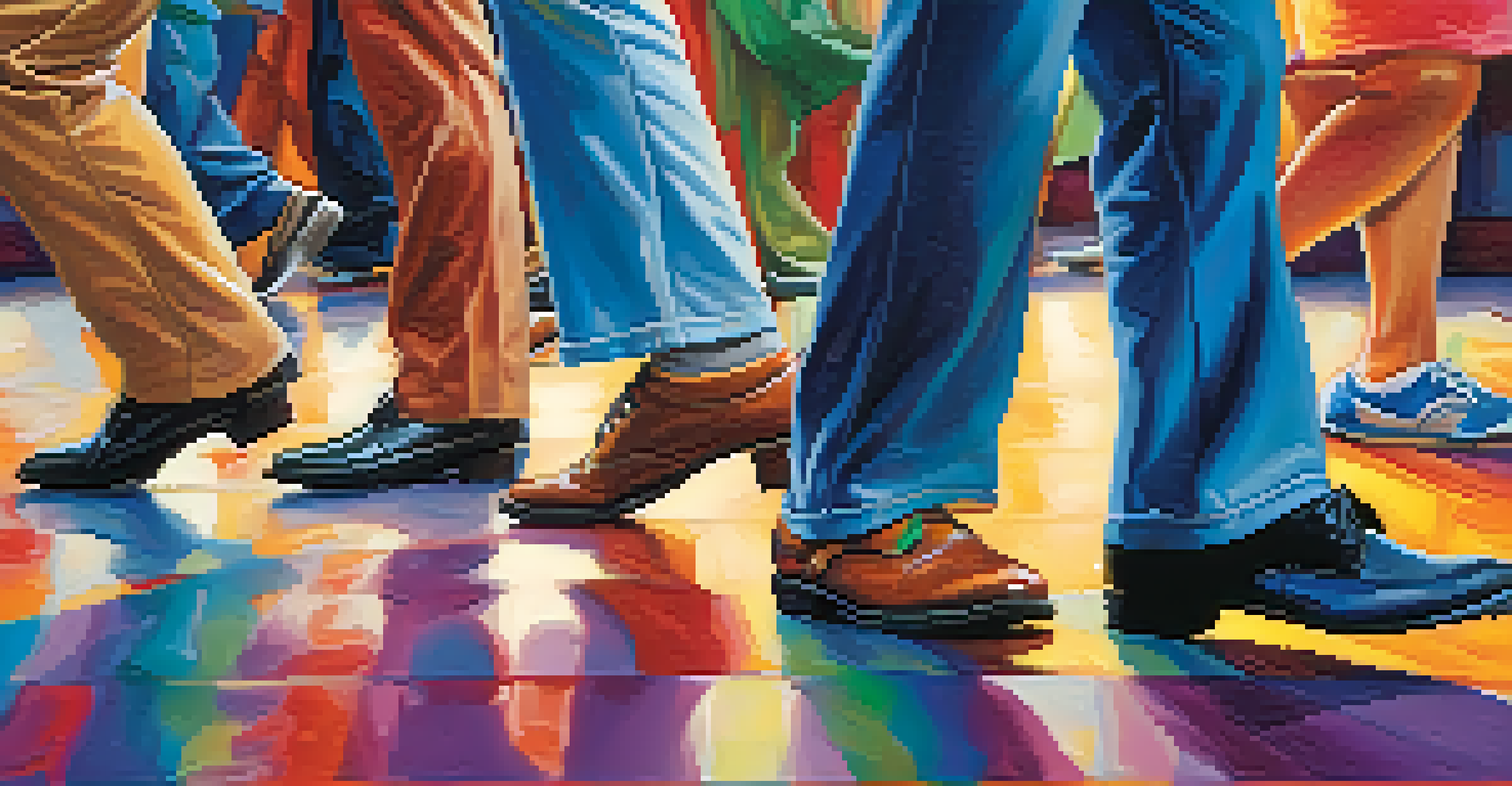Dance and Memory: Enhancing Cognitive Function in Seniors

The Connection Between Dance and Brain Health
Dance is more than just physical movement; it offers a unique blend of mental and physical engagement that can significantly benefit brain health. When seniors dance, they not only move their bodies but also engage their minds, which can help stimulate neural pathways. This dual engagement is crucial as it promotes cognitive flexibility, allowing for better memory recall and processing speed. It’s akin to a workout for the brain, where each step and rhythm can enhance overall cognitive function.
Dance is the hidden language of the soul.
Research suggests that dance can improve various aspects of cognitive function, including memory, attention, and even problem-solving skills. For instance, learning new dance routines challenges the brain to remember sequences and patterns, which can enhance memory retention. Moreover, this social activity often involves interaction with others, adding another layer of cognitive engagement that solitary activities might lack. Essentially, dance combines physical exercise with mental challenges, fostering a well-rounded approach to brain health.
Incorporating dance into daily routines can lead to significant improvements in mental agility. Just like exercise strengthens the body, dance strengthens the mind. This holistic approach to health is especially important for seniors, who may face the decline in cognitive abilities as they age. By making dance a regular part of life, seniors can enjoy both the physical and mental benefits, keeping their minds sharp and engaged.
How Dance Enhances Memory in Seniors
Memory is a complex process that can be positively impacted by the rhythmic and repetitive nature of dance. When seniors engage in dance, they often have to recall steps and sequences, which exercises their memory in a fun and enjoyable way. This practice can lead to improved recall in everyday tasks, as the brain becomes more adept at storing and retrieving information. Think of it as a memory workout that can be both enjoyable and beneficial.

Furthermore, dance often involves listening to music, which can evoke emotional memories and enhance cognitive function. The brain processes music and dance in a way that can trigger nostalgia and happy memories, creating a positive feedback loop. This emotional connection can make it easier for seniors to remember more recent information as well. By associating movements with music, seniors can create strong mental links that bolster their memory.
Dance Boosts Brain Health
Engaging in dance promotes cognitive flexibility and enhances memory recall, benefiting overall brain health.
As seniors dance, they also engage various brain regions responsible for coordination, balance, and memory. This multifaceted engagement stimulates neuroplasticity, the brain's ability to form new connections and adapt. With each dance session, seniors are not just improving their physical capabilities; they are also giving their brains a chance to grow and thrive. In essence, dance becomes a powerful tool for enhancing memory and cognitive health.
The Social Benefits of Dance for Seniors
One of the most significant advantages of dance for seniors is its social aspect. Many dance activities involve groups or partners, creating an environment that fosters social interaction. This social engagement is crucial for mental health, as it reduces feelings of loneliness and isolation, which can negatively impact cognitive function. When seniors dance together, they not only share physical movement but also laughter and camaraderie, enriching their lives.
Dancing is like dreaming with your feet.
Moreover, dancing in a group can build a sense of community, which is vital for emotional well-being. Group activities encourage friendships and support networks, providing seniors with a sense of belonging. The joy of shared experiences can enhance mood, which is closely linked to cognitive performance. In this way, dance serves as a bridge to social connections, making it a holistic activity for both body and mind.
In addition, social dance often involves learning from one another, whether through teaching or collaborating on routines. This exchange of knowledge and skills can further enhance cognitive abilities, as seniors challenge each other and share tips. By engaging socially through dance, seniors can enjoy a richer, more fulfilling life, all while boosting their cognitive function in the process.
Dance Styles That Benefit Cognitive Function
Not all dance styles are created equal when it comes to cognitive benefits. Styles that require memorization of steps, such as ballroom dancing, line dancing, or swing, can be particularly effective. These forms of dance challenge the brain to remember sequences and improve coordination. Just think of it as a puzzle where each step is a piece that fits into a larger picture, enhancing memory and cognitive function over time.
Additionally, improvisational dance styles, like modern dance or freestyle, encourage creativity and spontaneity. These forms allow seniors to express themselves freely, which can stimulate cognitive processes related to decision-making and problem-solving. The freedom to create and innovate can lead to a more active mind, as seniors learn to navigate their movements in new and exciting ways. It's like giving the brain a playground to explore and grow.
Social Interaction Matters
Dance fosters social connections among seniors, reducing feelings of loneliness and enhancing emotional well-being.
Moreover, dance styles that incorporate cultural elements, such as salsa or folk dance, can enrich cognitive function by connecting seniors to their heritage and community. Learning about the history and significance of these dances can add layers of meaning and engagement. This cultural connection not only enhances the enjoyment of dancing but also stimulates brain activity, ensuring that the cognitive benefits are both deep and lasting.
The Science Behind Dance and Cognitive Improvement
Scientific studies have shown that engaging in dance can lead to measurable improvements in cognitive function among seniors. A study published in the New England Journal of Medicine found that frequent dancing was associated with a lower risk of dementia. This finding underscores the importance of incorporating dance as a regular part of wellness programs for seniors. It’s fascinating how a fun activity can have such profound effects on brain health.
Additionally, dance can enhance neuroplasticity, which is the brain's ability to reorganize itself by forming new neural connections. This plasticity is crucial for maintaining cognitive function as we age. When seniors learn new dance routines, they are essentially training their brains to adapt and grow, much like how muscle strength improves with physical exercise. The brain, like any other part of the body, benefits from regular activity and stimulation.
Moreover, researchers have identified that dance activates areas of the brain associated with memory and spatial awareness. This stimulation can lead to improved performance in daily activities that require these skills. As seniors dance, they are engaging multiple brain systems simultaneously, promoting overall cognitive health. It is a compelling reminder that keeping active through enjoyable activities can lead to lasting benefits for the brain.
Incorporating Dance into Senior Lifestyle Programs
To maximize the cognitive benefits of dance, it's essential to incorporate it into senior lifestyle programs. Community centers, retirement homes, and senior clubs can offer dance classes tailored specifically for older adults. These classes can range from gentle movement to more energetic styles, ensuring that there's something for everyone. By creating accessible dance opportunities, seniors can easily integrate this beneficial activity into their daily routines.
Moreover, combining dance with other forms of exercise can create a comprehensive wellness program. Activities like yoga or tai chi can complement dance by enhancing flexibility and balance. This multifaceted approach not only improves physical health but also boosts cognitive function. It's like building a well-rounded meal for the body and mind, ensuring that all nutritional needs are met.
Diverse Dance Styles Count
Different dance styles, such as ballroom and improvisational dance, provide unique cognitive benefits through memorization and creativity.
Finally, encouraging family members to join in on the dance can further enhance the experience. When relatives participate, it strengthens bonds and creates lasting memories. This shared experience can be incredibly rewarding, making the dance not just a physical activity but a cherished family tradition. By fostering an environment where dance is embraced, families can contribute to their loved ones' cognitive health and overall happiness.
Conclusion: Embracing Dance for a Brighter Future
In conclusion, dance offers a captivating way for seniors to enhance their cognitive function and memory. By engaging both the body and mind, dance transforms the act of moving into a powerful tool for mental health. As we've explored, the benefits of dance extend beyond simple enjoyment; they encompass improved memory, social connections, and overall cognitive vitality. It's a holistic approach that can truly enrich the lives of seniors.
As communities embrace the role of dance in senior wellness, it’s essential to promote inclusivity and accessibility. Encouraging seniors to participate in dance not only fosters better cognitive health but also creates a vibrant community where everyone can thrive. It’s about creating spaces where joy and movement intersect, allowing seniors to experience the full range of benefits that dance offers.

Ultimately, embracing dance as a regular practice can lead to a brighter and more fulfilling future for seniors. It's a joyful path to cognitive enhancement and a testament to the power of movement. So, let’s lace up those dancing shoes and step into a world where memory and joy merge, enhancing life one dance at a time.